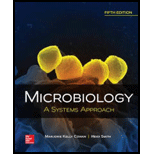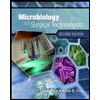
Microbiology: A Systems Approach
5th Edition
ISBN: 9781259706615
Author: Marjorie Kelly Cowan Professor
Publisher: McGraw-Hill Education
expand_more
expand_more
format_list_bulleted
Concept explainers
Question
Chapter 17, Problem 14TF
Summary Introduction
Introduction:
Microbes are organisms that are not visible to naked eyes. They are cosmopolitan and are even found in extreme environments. They can be found in extremely acidic environments or alkaline environments, in extremely hot environments such as hydrothermal vents of deep sea and hot springs, in extremely freezing environments such as Antarctic ice, and also in extremely salty environments.
Expert Solution & Answer
Want to see the full answer?
Check out a sample textbook solution
Students have asked these similar questions
Which evidence-based stress management techniques are most effective in reducing chronic stress and supporting college students’ academic success?
students in a science class investiged the conditions under which corn seeds would germinate most successfully. BAsed on the results which of these factors appears most important for successful corn seed germination.
I want to write the given physician orders in the kardex form
Chapter 17 Solutions
Microbiology: A Systems Approach
Ch. 17.1 - Prob. 1AYPCh. 17.1 - Prob. 2AYPCh. 17.1 - Prob. 3AYPCh. 17.1 - Prob. 4AYPCh. 17.2 - Summarize the most common methods used for direct...Ch. 17.2 - Prob. 6AYPCh. 17.2 - Prob. 7AYPCh. 17.3 - Prob. 8AYPCh. 17.3 - Differentiate between sensitivity and specificity.Ch. 17.3 - Explain how fluorescent antibodies can be used in...
Ch. 17.3 - Prob. 11AYPCh. 17.3 - Prob. 12AYPCh. 17.3 - Prob. 13AYPCh. 17.3 - Explain the difference between a direct and an...Ch. 17.4 - Prob. 15AYPCh. 17.4 - Prob. 16AYPCh. 17.4 - Prob. 17AYPCh. 17.5 - Prob. 18AYPCh. 17.5 - List the major advantages of microarray methods of...Ch. 17.5 - Summarize the benefits of using whole-genome...Ch. 17 - Prob. 1MCQCh. 17 - Prob. 2MCQCh. 17 - Prob. 3MCQCh. 17 - Prob. 4MCQCh. 17 - Prob. 5MCQCh. 17 - Prob. 6MCQCh. 17 - Prob. 7MCQCh. 17 - Prob. 8MCQCh. 17 - The Western blot test can be used to identify a....Ch. 17 - Prob. 10MCQCh. 17 - True-False Questions. If the statement is true,...Ch. 17 - Prob. 12TFCh. 17 - Prob. 13TFCh. 17 - Prob. 14TFCh. 17 - Prob. 15TFCh. 17 - Explain why specimens should be taken aseptically,...Ch. 17 - Prob. 2CTQCh. 17 - Explain which type of ELISA can be used to...Ch. 17 - Prob. 4CTQCh. 17 - Prob. 5CTQCh. 17 - Prob. 1VCCh. 17 - From this chapter, figure 17.14. Can you explain...Ch. 17 - Prob. 1CM
Knowledge Booster
Learn more about
Need a deep-dive on the concept behind this application? Look no further. Learn more about this topic, biology and related others by exploring similar questions and additional content below.Similar questions
- Amino Acid Coclow TABle 3' Gly Phe Leu (G) (F) (L) 3- Val (V) Arg (R) Ser (S) Ala (A) Lys (K) CAG G Glu Asp (E) (D) Ser (S) CCCAGUCAGUCAGUCAG 0204 C U A G C Asn (N) G 4 A AGU C GU (5) AC C UGA A G5 C CUGACUGACUGACUGAC Thr (T) Met (M) lle £€ (1) U 4 G Tyr Σε (Y) U Cys (C) C A G Trp (W) 3' U C A Leu בוט His Pro (P) ££ (H) Gin (Q) Arg 흐름 (R) (L) Start Stop 8. Transcription and Translation Practice: (Video 10-1 and 10-2) A. Below is the sense strand of a DNA gene. Using the sense strand, create the antisense DNA strand and label the 5' and 3' ends. B. Use the antisense strand that you create in part A as a template to create the mRNA transcript of the gene and label the 5' and 3' ends. C. Translate the mRNA you produced in part B into the polypeptide sequence making sure to follow all the rules of translation. 5'-AGCATGACTAATAGTTGTTGAGCTGTC-3' (sense strand) 4arrow_forwardWhat is the structure and function of Eukaryotic cells, including their organelles? How are Eukaryotic cells different than Prokaryotic cells, in terms of evolution which form of the cell might have came first? How do Eukaryotic cells become malignant (cancerous)?arrow_forwardWhat are the roles of DNA and proteins inside of the cell? What are the building blocks or molecular components of the DNA and proteins? How are proteins produced within the cell? What connection is there between DNA, proteins, and the cell cycle? What is the relationship between DNA, proteins, and Cancer?arrow_forward
- please fill in the empty sports, thank you!arrow_forwardIn one paragraph show how atoms and they're structure are related to the structure of dna and proteins. Talk about what atoms are. what they're made of, why chemical bonding is important to DNA?arrow_forwardWhat are the structure and properties of atoms and chemical bonds (especially how they relate to DNA and proteins).arrow_forward
- The Sentinel Cell: Nature’s Answer to Cancer?arrow_forwardMolecular Biology Question You are working to characterize a novel protein in mice. Analysis shows that high levels of the primary transcript that codes for this protein are found in tissue from the brain, muscle, liver, and pancreas. However, an antibody that recognizes the C-terminal portion of the protein indicates that the protein is present in brain, muscle, and liver, but not in the pancreas. What is the most likely explanation for this result?arrow_forwardMolecular Biology Explain/discuss how “slow stop” and “quick/fast stop” mutants wereused to identify different protein involved in DNA replication in E. coli.arrow_forward
arrow_back_ios
SEE MORE QUESTIONS
arrow_forward_ios
Recommended textbooks for you
- Understanding Health Insurance: A Guide to Billin...Health & NutritionISBN:9781337679480Author:GREENPublisher:CengageEssentials Health Info Management Principles/Prac...Health & NutritionISBN:9780357191651Author:BowiePublisher:Cengage
 Microbiology for Surgical Technologists (MindTap ...BiologyISBN:9781111306663Author:Margaret Rodriguez, Paul PricePublisher:Cengage Learning
Microbiology for Surgical Technologists (MindTap ...BiologyISBN:9781111306663Author:Margaret Rodriguez, Paul PricePublisher:Cengage Learning


Understanding Health Insurance: A Guide to Billin...
Health & Nutrition
ISBN:9781337679480
Author:GREEN
Publisher:Cengage

Essentials Health Info Management Principles/Prac...
Health & Nutrition
ISBN:9780357191651
Author:Bowie
Publisher:Cengage



Microbiology for Surgical Technologists (MindTap ...
Biology
ISBN:9781111306663
Author:Margaret Rodriguez, Paul Price
Publisher:Cengage Learning
cell culture and growth media for Microbiology; Author: Scientist Cindy;https://www.youtube.com/watch?v=EjnQ3peWRek;License: Standard YouTube License, CC-BY